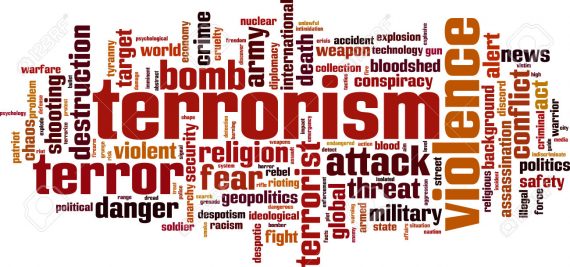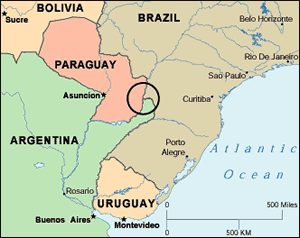Hezbollah in Latin America! (Part Gazillion)
A possible murder plot in Colombia embedded into a problematic multi-decade narrative.

So, yesterday in looking for news updates on Colombia’s ELN (National Liberation Army) I came across this headline: Is Iran the ‘Common Enemy’ of Israel and Colombia? which included this opening paragraph:
In late June, Colombian authorities neutralized a possible Iranian-backed assassination plot in Bogota that could have killed two Israeli businessmen on Colombian territory. The plot, which began to unravel in April, involved an Iranian operative, Rahmat Asadi, who allegedly recruited two Colombian cutouts to carry out the operation.
Sounds quite serious, yes? Yet, it got my skepticism sense tingling, so I left the tab open for a return visit. Could this be a chance to revisit my post from July of 2010, How to Spot Bogus “The Jihadists are Hooking up with Latin American Drug Cartel” Stories?
While it is not a perfect fit, it did have some key elements.
Here’s the deep background: in the aftermath of the September 11, 2001 attacks on the United States, there was an effort to construct an expansive war on terror paradigm that saw a possible interconnectedness of any and every terrorist organization in the world. This is how we got the Bush Administration’s Global War on Terror, an ultimately amorphous beast that really ended up meaning certain groups in the Middle East. But, it should be noted, that it had effects across the globe, including Latin America (I even wrote a book chapter on how the Bush administration’s rhetoric affected policy on the ground in Colombia).*
One of the things this led to was an ongoing series of stories written about how al Qaeda (or ISIS or Hezbollah, etc.) were connected to groups in Latin America so that they could either disrupt the region or, more often than not, use Latin America to launch attacks on the US. **
These stories often combine the fear of Muslims with the fear of Latin American immigrants. A classic example is from 2014 when former Representative Duncan Hunter (R-CA) claimed that ISIS fighters had been captured at the US-Mexican border (they hadn’t). Or, for a more recent example, here’s an opinion column from the Washington Times from August: How many terrorists will cross into the U.S. through Mexico?
In early February, less than two weeks after Biden took over from his predecessor, Border Patrol agents in Yuma, Arizona, apprehended a group of 11 Iranian citizens who illegally crossed the border into the United States.
In March, Axios reported that the Customs and Border Protection agency told members of Congress that since the start of the fiscal year on October 1, 2020, four individuals apprehended at the southern border matched names on the FBI’s Terrorist Screening Database. Three were from Yemen and one was from Serbia.
Oh dear, Iranians at the doorstep! Four names matched a database! The republic is doomed, no doubt.
This is where I always feel it necessary to point out that there are far easier ways to get into the country than crossing the US-Mexican border. We do remember how the 9/11 hijackers got it, right? If global terrorist networks are as sophisticated and scary as the fear-mongers make them out to be, I think they can figure out all of this as well. Part of what gets me about all of this is that these theories of threats from border-crossing terrorists are now twenty years old and yet there has been no actual, you know, evidence, that the threat is real.
But, as the column asks the fearmongering “what if?” question: “What about the ones we don’t succeed in apprehending?”
Scary, right? I mean, who knows what evil lurks amongst the migrant hordes?
After all, “what is to prevent an influx of Afghanistan-launched terrorists from sneaking across that border and into our country to plot mayhem and commit murder against our fellow citizens?”
Well, probably the vast distance coupled with logistical and expense-related barriers (oh, and probably the desire not to have their country re-invaded, among a host of other reasons).
But, I digress. I was here to talk and Hezbollah and Colombia.
The piece linked above about an assassination plot is from the Middle East Forum, a site run by Daniel Pipes, a known agitator on topics of Islam and the Middle East, so none of this is surprising.
I will admit, there is at least some story here, insofar as El Tiempo did report on an alleged plot to kill two Israelis in Colombia. An English version of the story (which is just a refernce to the El Tiempo story without new reporting) can be found via the Times of Israel: Hezbollah planned to murder Israeli in Colombia to avenge Soleimani – report.
And, yes, the Colombian Minister of Defense, Diego Molano, did say, “Iran and Hezbollah are enemies of Colombia” and that they were “common enemies” of both Colombia and Israel during a visit to Israel this month. I would be remiss not to note that the current Colombian administration is on the rightward side of things, and is prone to playing up terrorism as a political issue. Even so, the Times of Israel piece reported that Molano backtracked on his comment (describing his comments as “hasty”) and then President Duque noted, “Colombia does not use the word ‘enemy’ to designate a country” while also noting “that does not mean that we don’t have divergences on specific questions with Iran.”
Haaretz further reported: Israel Extracts Ex-intel Official From Colombia Amid Hezbollah Assassination Plot, Report Says
Speaking with Haaretz last week, Duque said that “We have included Hezbollah in our terrorist list. So whatever we can do to prevent Hezbollah activities, to denounce Hezbollah activities and to undertake operations that will lead to the capture of terrorist cells, we will very clearly do it.”
“Now in the case of Iran, Colombia has had diplomatic relations with Iran for a long, long time. But Colombia has also made it very clear that no country can have relationships with groups that are terrorists. So in that sense we will be the first to denounce any link that could derive from a connection between Hezbollah and any government.”
Having said all of that, it is highly unclear how much of this was a major example of transnational terrorism.
This leads me back to my How to Spot Bogus “The Jihadists are Hooking up with Latin American Drug Cartel” Stories? In that post I noted the following red flags:
- No legitimate or known source/very thin sourcing.
- It mentions the Tri-Border Area (where Argentina, Brazil, and Paraguay come together).
- It Mentions Alleged Hezbollah Bombings in Argentina.
As to #1, as noted above, the sourcing on this story is a bit vague, but I will say that it stronger than most stories in this genre. There were two individuals expelled from Colombia who had possible Hezbollah ties. But, I would note, there was clearly not enough evidence of a criminal plot to arrest them, and the ties to Hezbollah were alleged. Here is Duque, again from Haaretz:
“We have been working in coordination with many authorities worldwide,” he said. “We have captured members of international terrorist cells in Colombia. Just a few days ago, we captured an ISIS member. Six months ago, we captured two persons who were presumably linked to Hezbollah, planning terrorist activities in Colombia. And we do this in very open and real-time cooperation.”
The vagueness in these stories is always striking, although I acknowledge there is more to this specific story than is usually the case. But, as noted, even those specifics require a lot of qualifiers and contingent language.
But the fun parts for me are numbers 2 and 3 because the Middle East Forum does not fail to deliver.
On #2 and #3:
That sobering lesson was learned in Latin America in 1994, with the brutal car bombing of the AMIA cultural center in Argentina that killed 85 people.
[…]
FARC and Hezbollah have a long history of collaboration dating back to the AMIA bombing, when a Colombian-born senior Hezbollah operative, Salman Raouf Salman, worked with FARC to smuggle explosives from Lebanon to the Tri-Border Area to use in the attack in Argentina.
The reason I note this is that it underscores the weakness of the overall threat theme. If the only significant example one can conjure about the alleged connection between Latin American and Middle Eastern terrorists is an event from 1994 then maybe the connections are not that strong. Further, the notion that the 1994 bombing is an illustration of a “long history of collaboration” between the FARC (which is now demobilized) and Hezbollah is just more than a stretch. And I continue to believe that the conjuring of the “Tri-Border Area” just sounds scary and action-moviesque as opposed to being anything of real significance. (I say all of this fully understanding and acknowledging the realities of transnational crime and violence in the region).
These stories also frequently note, as this one does, the presence of Lebanese immigrants to Latin America in a vague and ominous way.
I would note, the Times of Israel story falls into the same trap:
Colombia has a sizable Lebanese community and Hezbollah has a presence in neighboring Venezuela as well as other Latin American countries. In addition, Hezbollah and Iran, its patron, have long been linked to the 1994 bombing that killed 85 people and injured hundreds at a Jewish center in Buenos Aires.
No reference to the Tri-Border region, however!
Look, as noted, there is a story here, which appears to perhaps be a case of Iran looking to retaliate against Israel for some of its targetted assassinations of Iranians. Several reports suggest that at least one of the targetted Israelis was a former Mossad agent. The linked ET piece suggests that this was a Quds operation (a branch of the Iranian Islamic Revolutionary Guard Corps) who were seeking to engage in criminal outsourcing of the job.
So, to make this into a Colombia-Iran conflict, or to try and fit it into the “Hezbollah is bringing terrorism to the Western Hemisphere” narrative is, like the narrative itself, a stretch.
(Believe it or not, I thought this was going to be a short post…).
*”Colombia: Democracy Under Duress.” in William J. Crotty, ed. (2005). Democratic Development and Political Terrorism: The Global Perspectives, Boston: Northeastern University Press.
**An example of this genre of story is discussed in my 2013 post, Iran, Hezbollah and Latin America? or my 2010 post Hezbollah Right Across the Rio Grande (or Something Like that).






The Muslim community in Mexico is tiny, and there are few people of Arab descent. The exception is a sizable Lebanese community, which includes well-known people like the billionaire Carlos Slim. The problem for would-be Islamist terrorists trying to blend in, is the Lebanese community is mostly Christian.
Well written. I wish we lived in a world where facts still mattered. Fox rules, facts don’t.
I’m afraid Steven is missing the big picture.
This story is proof that the evil alliance is falling apart, as Iranians attack Bolivians! Thanks, President Trump!
I’ve had a slight fascination of the 20th Century (and late 19th) immigration patterns to Latin America (to include Mexico), much of which happened after the USA’s surge. Many Americans think the USA was the only country in the Americas that had large immigration from all over, and that most in Latin America are indigenous or of Spanish descent (totally ignoring that Brazil was Portuguese, Hispanic yes, but not Spanish speaking). In college a friend was from a Chilean-Greek banking family, and I knew several Hong Kongese with family in Costa Rica and Panama. And Mexico is not Costa Rica is not Venezuela is not Brazil.
With the fall of the Ottoman Empire around the end of World War I there was a large Syrano-Lebanese (mostly Christian) diaspora to Latin America. As Kathy relates above regarding Mexico Carlos Slim’s family, but also Selma Hayek’s (her retreat house is 25 miles from me). Likewise the Austria-Hungarian Empire created immigrants to Latin America (Brewmaster for Modelo Beer, so Negra Modelo is a Vienna Lager). Al Pastor style of cooking in Mexico came from Middle-Eastern shepherds, adapted for local ingredients. [And a few Nazi, under 1%, but that is another broken trope.]
I’ll add in the pre-1930 Japanese immigration to Peru and Brazil, the Chinese farmers on the West Coast of Mexico (particularly around Mexicali BCN – great fusion Mexican food there but way off the tourist map), the Italians to Argentina, the Welsh to Patagonia, etc. Jews fleeing the Inquisition even earlier. The hero of the Chilean Revolution is O’Higgins. Complicated.
OMG, Lebanon has Hezbollah, Latin America has Lebanese – um, not so fast to connect the dots. Lots of Lebanese in the USA too (I know one who is a SouthWest pilot – zero chance his Orthodox family supports Hezbollah – sworn enemies – but he’s American and doesn’t care). And Paraguay was for years a “wild west,” so more like the Jersey mob (so we’re pot calling kettle black).
My family had (legit) business dealings with Meyer Lansky of the Vegas mob (we were part of his money laundering ~1974) – my point being similar corruption in the USA.
More on Middle Eastern immigration to Latin America https://immigration.ucr.edu/what-we-know/immigrants-in-latin-america/